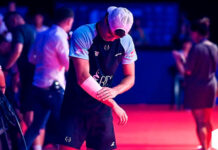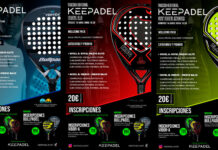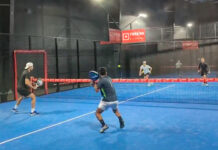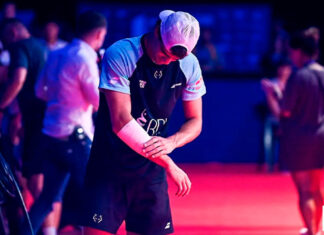Padel World Press .- As he told us Manu Martín, paddle tennis is a sport with a great tactical load. A player who starts and acquires basic defensive skills quickly becomes a tough opponent. There is a phrase that defines this concept very well: “In paddle tennis, the one who wins the most does not win but the one who loses the least”. If we count the number of winning shots that are made in a match, and the number of mistakes made, the balance tends to be thrown out of balance in favor of the mistakes made. When it comes to minimizing failures, there are several variables that can be studied. In this article we are going to focus on the plays.
What is the Play?
The generic definition of play is "action to intervene the player when it is his turn". For the paddle, it is necessary to qualify some aspects:
- The paddle play usually has at least two strokes: given the difficulty of obtaining a winning point, they must be carefully prepared and, at least, two strokes are needed: one preparatory and one that will define the point.
- The paddle play is made regardless of which player hits the ball: when a couple raises a play, they must be clear about the scheme that is going to be carried out. If the server initiates a play and the receiver tries to neutralize it by playing the ball on his partner, the latter must know the play in advance and continue it.
- The player with the ball intervenes in the play, but also the player who does not have it. A very common mistake in beginners is to adopt a static position when the ball is being hit by the partner. The player without the ball has part of the responsibility in achieving the play ... And depending on their position on the court, the opponents will have to stick to the options that their position allows them to play.
Let's analyze the elements that can improve your game:
The point consists of one or several moves ... Learn to recognize them.
To explain this concept we will resort to an example. The serve player performs a service to the T from the wrong side and goes up to the net. The receiver returns the ball on the backhand volley of the punch (hit that is usually less aggressive), which connects a backhand volley on the fence. At this moment, the 'voleador' is waiting for the ball to generate a bad rebound and the point ends. In case that is so ... Great! Goal achieved.
The second option is for the ball to be returned, either to the player who connected the volley or to his team-mate, so that the play will continue, if possible, on the same player since he is displaced and the 'voleadores' are tipped on that side of the game.
If the point falls on the side of the 'voleadores', great! goal achieved ... But this situation may lead us to the third option: at some point, the point is equal, either by a balloon of the players who are in the background, by a little girl, or by a bad volley. It is at this moment when the play ends and another begins.
In players with little experience, the difficulty in recognizing, or accepting, that they must start another play again leads them to lose patience and take extreme risks to define the point. It is at this point when the choice of the shot and its parameters (direction, speed, height, spin ...) is done in an inappropriate way, which translates into a missed ball.
Remorse and Compensation
The term remorse in the player of padel I borrow it to refer to the feeling of guilt that has the player who feels that he has taken a bad decision. It can be for two reasons:
- By blur: for example, when you have had the option to end with a period and have not done so. It may happen that at one point during the play, the ball is 'given away' and the fear of failing makes it more conservative, restoring the balance of the play. If this point is lost, a feeling of guilt usually appears and as compensation, in the next ball that comes back and is within range, he will try to define to correct his mistake.
- Due to lack of consistency: the opposite happens when, after missing a winning shot, a ball is played that is delivered conservatively and the play is extended or even just hand of the rivals.
When you have an opportunity, take advantage of it
Sometimes we coaches put a lot of emphasis on consistency with our players. Without a doubt, the first objective that a shot must fulfill is to bounce in the opposite field. Without conflicting with this maxim, the next step is to be clear that if there is a ball that 'can' miss, it is the one that was delivered and with definition options. If it's not about taking advantage of an easy ball, then how are they going to do it with difficult ones?
Poses a play and perseveres
In order to draw conclusions about the results of the plays, it is important to know how to define the beginning and end of each and, above all, the reasons why this happens. For this, it is not enough to observe a single play and based on it make a decision. For example, if we have decided to try to play on a specific place of our rivals because we have perceived a possible gap in their game, and yet our attempts are frustrated, it should be repeated a couple of times before giving up. Maybe little by little you lose confidence, or you might even play a shot and it worked out well, but you will not be able to have continuity with your answer, and leaving early would not be a good option.
If after several attempts, the play is neutralized at the same point, it is obvious that it must be dealt with in another way or replaced by another one since it is not giving the expected result.
Machines the basic plays in training
Pick three basic plays and practice them to use in the game. The more internalized you have them, the less time you will need to choose the place where you will place the ball. Make these plays in training with your partner, in such a way that if the opponents divert the game towards your partner, he can give it continuity and finish it.
Little by little, add plays to your repertoire once you have overcome the previous ones.
I hope these tips help you improve your performance or that of your players on the track.
Greetings and see you on the tracks.
Manu Martín
Image: Facebook Bullpadel
* You can follow all the news of the world of paddle in our profiles of Facebook y Twitter as well as subscribe to our Newsletter .












